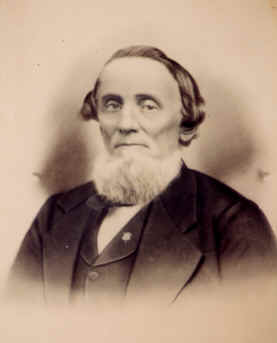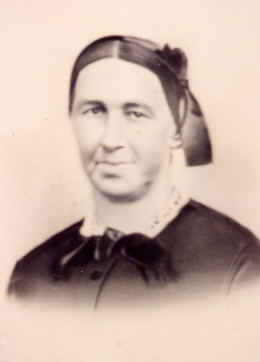CHARLES E. WELLS and HANNAH COMPTON |
||
|
(1814-1893) |
(1821-1888) |
|
|
Great-grandmother Hannah Compton Wells died in April 1888, two months before her 67th birthday. Her great-granddaughter, my grandmother Fern Hawkins, wasn’t born until six years later. Consequently, not much of substance was carried down through the years about this ancestor. In fact, the only times her name came up in my hearing two generations later was in mention of a bad trait in the family—"She must have gotten that from Great-grandmother Wells." Since I'm quite sure you didn't deserve that, Grandmother, may I offer our collective apologies? (That family habit has not continued in my generation.) Obtaining the quotes from her Bible in 1951 (see Hannah’s Bible) gave us information about her no one had had before. What struck us as most interesting at that time was the information about her grandfather who died in the American Revolution and his ancestor Spencer Compton who had died in 1643 fighting the Parliamentarian forces that ousted England's King Charles. (Hannah's Bible called them "Cromwell's forces," but we now understand that Cromwell did not come into the picture until a few years later.) Husband CharlesHannah Marie Compton, the youngest of the eleven children in her family, was my third great-grandmother. While we’ve had plenty of information about the Comptons down through the generations, we’ve had only scraps of information and speculations about C.E. Wells, the man Hannah married. As recently in March 2012, that was about it. I knew that from some census work my nephew/webmaster had gained a few clues about C.E.’s family and roots, and I encouraged him to write up at least what he knew at that point. In the end, he wrote me two pages, and that research turned up some significant things about his life and Hannah’s. We now know that his name was Charles, that his family had also lived in Tyrone when he was growing up, and that he had as many as three brothers and five sisters. You can read here the full story of how Matt sorted out that mystery: C.E. Wells. So Charles and Hannah had sizable extended families on both sides, not just the Comptons. Since Charles’ father and his family were in Tyrone by the time he was ten or eleven, it is possible he and Hannah knew each other quite well while growing-up. Since Charles was seven years older than she and she was less than sixteen when they married, it is possible he did some waiting for her to grow up—just as another young man would do for one of their daughters years later. Though we have a lot more to learn about Charles’ siblings and what happened to his mother, it has been interesting to learn that he and Hannah had a large family on both sides during their years in Tyrone, New York. Gaining and Losing FamilyCharles and Hannah had been married three years and their first baby, Marcia Almira, was eleven months old in the late summer of 1840 when illness (we assume) struck the community. First, her brother David’s fourteen-year-old daughter, Effie, died. Within ten days, four younger nieces and nephews also died. Her brother William and his wife lost two on the same day, and they buried them in a common grave. Four of those who died are buried in a little cemetery on what would become Donovan Hill. Her brother Peter also lost a little girl, age two, but she is buried in the old cemetery at Sugar Hill where two siblings had been buried years earlier. Even though the Wells family escaped the death angel (perhaps the epidemic did not reach as far as the town of Tyrone), it is hard to imagine what a tragic and emotional time it must have been for the whole family. Hers and Charles’ second baby, Marion Elizabeth, was born in November of that year, 1841. The same month she was born, her Aunt Annie’s tenth child, Seymour Runyen Lockwood, turned ten. How soon everyone started calling her Minnie is unknown, as well as how long it was before cousin Seymour took a shine to her and decided he would wait for her to grow up. More on that in a moment. Charles and Hannah’s third child, in 1843, was another girl, and she became my great-great-grandmother. For a while, we weren’t sure if her name was Roxana or Roxanne, Sophrona or Sophronia, or indeed which of the two came first, but we now know from the Stauffer family Bible that is was Sophrona Roxana. And we’ve recently discovered that one of Charles’ brothers married a lady named Roxana, so there is the possibility that had something to do with Charles and Hannah giving the name to their daughter. Apparently she was known as Roxy most or all of her life (perhaps from the beginning to distinguish her from her aunt?), and that is the name on her tombstone. Moving onIn 1846, the family moved from Tyrone, in Schuyler County, New York, a bit further south to Painted Post, in Steuben County. We haven’t found anything on why they made that move. Two years later, another sister was born. They named her Mary Jane, but she would go through life as Jane. She would grow up to marry the younger brother of the man Roxy would marry—but that is another story (see Samuel Stauffer). In Painted Post—and likely in Tyrone, Charles appears to have supported his family as a grocer. A descendant, Marilyn Averill Towar of Flint, Michigan, and a great-granddaughter of Roxy’s (I’m a great-great-), had a tray that had been in her family for years. When she removed the picture on the surface, she found underneath two family treasures that had been used for lining the tray. One was an artist’s sketch of Painted Post and the other a grocery poster with Charles Wells’ name on it. The poster is fascinating reading all the way through, and it reveals a lot of the Charles’ character and the world they lived in. In 1854, after six years in Painted Post, the Wells family came to the huge decision to make an even greater move. They set out for Michigan. Marcia was 15, Minnie 13, Roxy 11, and Jane 6. Had young Seymour Lockwood decided by then that Minnie was the girl he wanted to spend his life with? It’s quite possible because the censuses tell us he too moved to Michigan between 1850 and 1860. Whereas for a long time we wondered about that move and what the attraction in Michigan was, we now know it was Charles’ family. His brother William had fought in the Mexican War in 1847 and had been awarded “land bounty rights” for his service. The land, however, was in western Michigan. We know that William and his sister Marilla moved their families to Michigan a few years earlier, and that has to be what inspired Charles and Hannah to do the same. Another sister of his, Asenath, also made the move between the 1850 and 1860 censuses, and she settled in the same township (Wright) as brother William. It would be interesting to know how those families traveled. Railroad travel was in its infancy, so it may have been by some traditional form of animal transport. The distance is six hundred miles, so it would have taken a fair length of time, no matter how they did it. It must have been exceedingly hard for Hannah to leave behind her three sisters and at least one brother, but she wasn’t totally without family members of her own in Michigan. At least one of her brothers, John P, made the move to Michigan, and perhaps her brother William as well after his wife died. See The Compton Clan for more about these two brothers. Expanding FamilyWeddings for the four Wells girls began three years after their move to Michigan. In 1857, 18-year-old Marcia married George Haas. Two years later, five months before she turned eighteen, Minnie and Seymour tied the knot. Who could have imagined that one hundred ten years after their wedding, the third and last child born to them (Guy was fourteen years younger than their second one), would plant a seed that would lead to their families’ stories being available to people all over the world. (See Hannah’s Bible.) The following summer in August 1860, not-quite-17-year-old Roxy was awarded a certificate to teach in the schools of Conklin, Michigan. She did not marry until 1865 when she was 22. The following year, Jane, 18, married George Stauffer, the brother of Roxy’s husband, Samuel. During the last decade of her life, Hannah would hear about the deaths of the last four of her siblings. In 1877 Susan and Hezekiah died in New York where they had spent their lives. In 1882, sister Annie (Anna) died. She, the oldest, had outlived all her siblings except Peter and Hannah. When Peter died in the Dakota Territory in 1885, I wonder how long it took the news to reach Hannah in southwestern Michigan? Charles and Hannah celebrated their 50th anniversary in 1887, the year before she died. They had seventeen grandchildren, at least half of them already adults. Marcia’s William Haas was twenty-eight, little Guy Lockwood was just six, and the youngest, Jane’s twins Claude and Maude Stauffer, were five. Their eighteen-year-old granddaughter, Rose (Jane’s oldest), must have already been struggling with her health because in July, a few months later, she died of consumption (tuberculosis). Hannah died April 28, 1888 (see husband’s Note written a month before her death), and Charles died five years later, April 27, 1893. No hint has survived of where or with whom he lived after Hannah’s death. They are buried in the Brooklawn Cemetery in the northwest corner of Grand Rapids (though several Internet sites call it Lawnbrook). (Dates of births, marriages, and deaths of the Wells daughters and some their descendants are also found in a Bible owned by Esther Hawkins Moneysmith and from a list on yellowed paper sent to Esther Gross, probably by Ruth Stauffer. The latter has the following at the bottom of the page: “These are the entries as I have them in my record and all I have. Signed, Carl A. Stauffer.” Carl was Jane Wells Stauffer’s second child.) |
||

